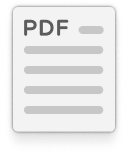‘Your e-mail failed because the attachment was too large’. Who hasn't experienced this frustrating message when trying to send a PDF document by email? Fortunately, there are effective solutions for optimising the weight of a PDF to ensure that it is sent without a hitch. Find out how to reduce the weight of your files for smooth, professional exchanges!
Why optimise the weight of a PDF when sending it by email?
To limit sending failures
Most e-mail systems impose a size limit on attachments (generally between 20 and 25 MB). If a document is too large, it will be blocked, giving rise to the notorious ‘failed to send’ message. By reducing the size of your PDF files, you increase your chances of a successful transfer on the first attempt.
Improve the user experience
A lightweight PDF file downloads faster, whether on a computer, tablet or mobile device. Similarly, smaller files require less storage space. By compressing your files, you can offer your recipients a better experience.
What techniques can be used to reduce the weight of a PDF?
Adjusting image quality
The quality of the images in a PDF has a major influence on its weight. Reducing the resolution of images is therefore often an effective solution. By going from a high resolution (300 DPI) to a more moderate resolution (150 DPI), the file weight can be significantly reduced.
Removing unnecessary elements
A PDF may also contain various elements that increase its weight, such as annotations, layers or metadata. Deleting these elements, which are often integrated by authoring software, reduces the final weight of the document. For example, if annotations are no longer necessary for the final reader, consider deleting them. The same goes for non-essential pages: think about deleting them.
Use online compression tools
The simplest and most obvious solution for reducing the weight of a document is to compress it. Online tools such as PDFSmart allow you to compress a PDF file quickly, without having to install any software.
PDFSmart is quick and easy to use. All you have to do is download the file, run the compression and then retrieve the optimised version. To top it all off, we use AES and ARC4 protocols to encrypt your data. So your sensitive or confidential PDF documents are safe.
Compress your PDF files with PDFSmart!
Steps to optimise the weight of a PDF with PDFSmart
Step 1: Access the compression tool
Start by visiting PDFSmart. Our compression tool is available from the main menu (in ‘Edit’ then ‘Compress’) or directly from the home page.
Step 2: Import the PDF file to be optimised
To download the right file, you have two options. You can import it from your device by clicking on ‘Import the PDF to be converted’ or from online sources such as URLs, Dropbox or Google Drive. PDFSmart also lets you drag and drop your document into the dedicated insert.
Step 3: Reduce the size of the PDF file
Once the document has been imported, you will need to set the compression parameters. By default, PDFSmart reduces the file size by 40-50%. But for very large documents, you can choose a higher compression of 70 to 80%. To help you make your choice, we will show you the approximate weight of your PDF document after compression. Then click on ‘Compress’ to start the file compression process.
Step 4: Download the compressed PDF
All that's left to do is download the new compressed file and send it by email. The sending error message should be a distant memory.
In conclusion
Optimising the weight of a PDF before sending it by email is essential to ensure that business communications run smoothly and without hindrance. With simple, accessible tools like PDFSmart, you can now easily lighten your documents. All while maintaining a high level of security and confidentiality.
Test the PDFSmart compressor for 7 days! This is the ideal time to optimise several files and discover the tool's other features, such as converting your PDF document, locking it with a password, editing it online or dividing it into several pages.






